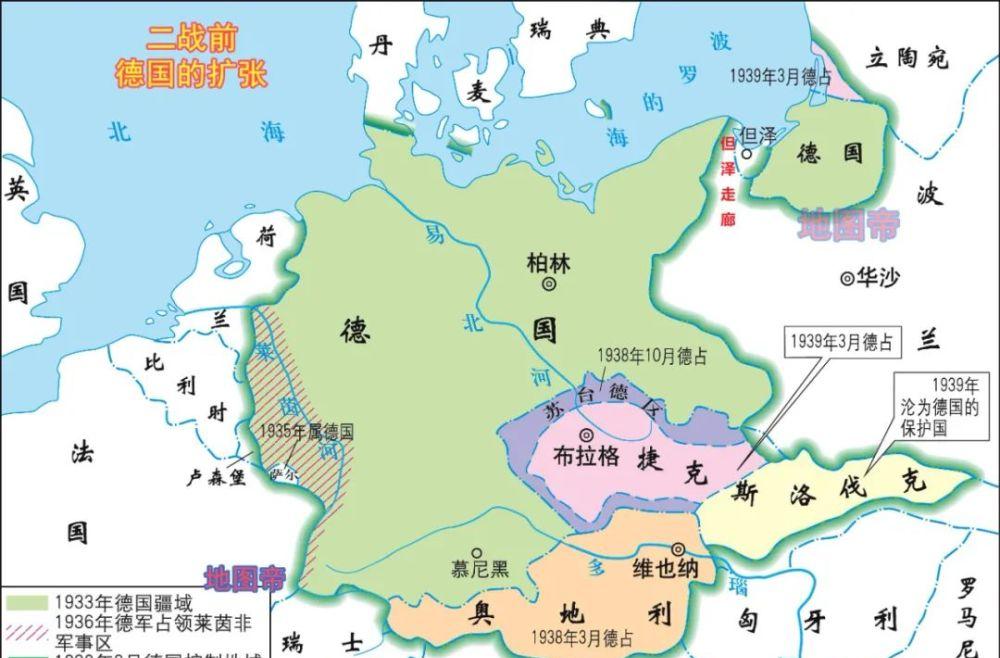In Pre-World War II Germany, east of East Prussia was not connected to the mainland, in the middle was a long and narrow piece of land, and the narrowest place in the north was about 40 kilometers wide, called the Danzig Corridor (Polish Corridor). For hundreds of years, this area was the focus of contention between the Germans and the Slavs (Poles), the Germans had to connect the east and the west, and the Poles needed to go to the sea.

Before World War I, the German Empire reached its peak and completely occupied the land.
The northern gulf of the Danzig Corridor (Polish Corridor), known to germans as Danzig Bay and Polish as Gdansk Bay. The deepest point of Gdansk Bay is 120 meters and the salinity is 0.7%.
In the southeast of Danzig Bay is the Bay of Vist (Kaliningrad Bay), which has only a narrow outlet to the sea, so the port of the Danzig Corridor naturally opens in Gdansk in the southwest, which is the outlet of the Vistula River.
The Vistula River, about 1,047 km long and with an average flow rate of 1,080 m3/s, originates in the Bezkid Mountains and flows from south to north through Krakow, Warsaw, Toruń, and finally into the Gulf of Gdansk in the Baltic Sea. The Wycław River runs through all of Poland, with a basin area of two-thirds of Poland's land area, and is known as the mother river of Poland.
At its peak, the Polish-Lithuanian Kingdom controlled a large area of land southwest of the Gulf of Gdansk, known to the Germans as West Prussia. In 1772, 1793 and 1795, Russia, Prussia and Austria jointly sent troops to divide the Kingdom of Poland and Lithuania three times, and the Danzig Corridor (Polish Corridor) belonged to the Kingdom of Prussia and the German Empire. The Germans occupied West Prussia, including the Danzig Corridor and surrounding lands, and East and West Prussia were united.
Before World War I, the city of Danzig in the Danzig Corridor was mostly German, but in other areas of the Danzig Corridor, there were slightly more Slavs (Poles) than Germans.
After the defeat of Germany in World War I, Poland acquired the danzig corridor except for the city of Danzig, which was administered by the League of Nations (the predecessor of the United Nations), so that East Prussia became an enclave. In fact, Poland could take East Prussia and leave West Prussia, including the Danzig Corridor, to Germany. However, the Anglo-French-dominated League of Nations wanted Poland to cut off Germany from the middle and turn East Prussia into an enclave, and Poland also wanted to get Germany's West Prussia and then find a way to encroach on East Prussia.
Not only that, Lithuania also took advantage of the danger and took the Memel region (Klaipeda region) north of East Prussia, which was originally entrusted by the League of Nations, and Lithuania did not care so much, and occupied it, and to this day this area is still on the lithuanian territory.
Early in World War II, Germany annexed the Rhine Demilitarized Zone, annexed Austria, and annexed Czechoslovakia. After completing the above actions, Germany naturally made a request for the "Danzig Corridor" for Poland. Because of the military commitment of Britain and France, Poland confidently and boldly rejected Hitler, germany immediately launched a blitzkrieg, and all of Poland fell, including the Danzig Corridor, and of course Lithuania was beaten into a pig's head by Germany.
In 1945, Germany was defeated again, and this time the east not only lost the Danzig Corridor and retreated from the Vistula River to the Oder River, but even East Prussia was incorporated into Poland, the Soviet Union (Russia) enclaves of Kaliningrad, and Lithuania.
After the end of World War II, the Soviet Union still occupied 201,000 square kilometers of Poland's territory, and the border pushed more than 200 kilometers westward. Poland's territory also moved more than 200 kilometers westward, compensated by Germany. Today, Poland covers an area of about 322,600 square kilometers, and nearly half of it comes from the German Empire at its height.
Time flies, the German Danzig has long been renamed Polish Gdansk, before World War II, 95% of the population of Danzig was German, after World War II most of them were expelled to East Germany west of the Oder River, and now the main ethnic group in Danzig is Polish, danzig has become an eternal pain in the hearts of Germans.
Text: Teacher Yan, Picture: Map Ji, welcome to reprint.